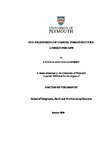Eco-engineering of coastal infrastructure: A design for life
| dc.contributor.supervisor | Firth, Louise | |
| dc.contributor.author | O'Shaughnessy, Kathryn | |
| dc.contributor.other | School of Geography, Earth and Environmental Sciences | en_US |
| dc.date.accessioned | 2020-07-08T12:56:26Z | |
| dc.date.available | 2020-07-08T12:56:26Z | |
| dc.date.issued | 2020 | |
| dc.date.issued | 2020 | |
| dc.identifier | 10541085 | en_US |
| dc.identifier.uri | http://hdl.handle.net/10026.1/15850 | |
| dc.description | Relevant publication from this thesis: O’Shaughnessy K. A., Hawkins, S. J., Evans, A. J., Hanley, M. E., Lunt, P., Thompson, R. C., Francis, R. A., Hoggart, S., Moore, P., Iglesias, G., Simmonds, D., Ducker, J. and Firth, L. B. 2019. Design catalogue for eco-engineering of coastal artificial structures: a multifunctional approach for stakeholders and end-users. Urban Ecosystems. DOI: 10.1007/s11252-019-00924-z. O’Shaughnessy K.A., Hawkins, S.J., Yunnie, A.L.E., Hanley, M.E., Lunt, P., Thompson, R.C. and Firth, L.B. 2020. Occurrence and assemblage composition of intertidal non-native species may be influenced by shipping patterns and artificial structures. Marine Pollution Bulletin. | en_US |
| dc.description.abstract |
Coastal urbanisation has driven humans to build artificial defences to protect infrastructure from rising sea level, erosion and stormier seas. Artificial structures are proliferating in the coastal and marine environments (“ocean sprawl”), resulting in a loss of natural habitat, species diversity and ecosystem services. To mitigate the impacts of ocean sprawl, the practice of eco-engineering of coastal infrastructure has been developed. A strong evidence base in support of eco-engineering is growing, yet there remain critical knowledge gaps. This work investigated the ecology of artificial structures and their ability to be enhanced in order to increase species diversity, addressing five knowledge gaps in the eco-engineering literature: (1) understanding of occurrence of non-native species in intertidal natural and artificial habitats along the south coasts of England; (2) looking beyond conventional measures of species diversity to better understand the differences in communities between natural and artificial habitats at multiple spatial scales; (3) comparing how topographic complexity shapes species diversity in both intertidal and subtidal habitats; (4) seeking generality of patterns of eco-engineering interventions across geographic localities; and (5) making the outcomes of eco-engineering research accessible in a practitioner-focused format for stakeholders. To address the first knowledge gap, Rapid Assessment Surveys (RAS) were conducted along the south coast of England. The central region of the south of England supported the most non-native species, while artificial and natural habitats differed in their assemblages of non-native species. Biological surveys in Plymouth Sound (UK) were conducted to address the second knowledge gap. α-diversity (taxon richness) was greater in natural compared to artificial habitats at multiple spatial scales, but β-diversity was greater in artificial compared to natural habitats at the larger spatial scale (m-km). To address the third and fourth knowledge gaps, habitat enhancement eco-engineering trials in Plymouth Sound in intertidal and subtidal habitats were conducted. Results were informally compared to those from equivalent experiments done along the Mediterranean coast of Israel. In general, habitat complexity had an effect on species diversity, but results were dependent on habitat and location. Lastly, an eco-engineering “user-guide” for practitioners was created that can serve as a template for future guides and frameworks as the science evolves and becomes freely accessible to end-users. This thesis evaluates outcomes in the context of their application to the management of eco-engineering in order to mitigate the negative effects of ocean sprawl. | en_US |
| dc.language.iso | en | |
| dc.publisher | University of Plymouth | |
| dc.subject | Eco-Engineering | en_US |
| dc.subject | Coastal Ecology | en_US |
| dc.subject | Biodiversity | en_US |
| dc.subject | Artificial Structures | en_US |
| dc.subject | Non-Native Species | en_US |
| dc.subject | Invasive species | en_US |
| dc.subject.classification | PhD | en_US |
| dc.title | Eco-engineering of coastal infrastructure: A design for life | en_US |
| dc.type | Thesis | |
| plymouth.version | publishable | en_US |
| dc.identifier.doi | http://dx.doi.org/10.24382/698 | |
| dc.rights.embargoperiod | No embargo | en_US |
| dc.type.qualification | Doctorate | en_US |
| rioxxterms.version | NA | |
| plymouth.orcid.id | 0000-0002-8587-4473 | en_US |
Files in this item
This item appears in the following Collection(s)
-
01 Research Theses Main Collection
Research Theses Main


